One of the “Pearls of the Alps”, just a few kilometers from Bressanone, committed to promoting sustainable and environmentally friendly tourism.
Val di Funes is located in South Tyrol, between the Isarco Valley and Val Gardena, and is one of the most picturesque valleys in the Dolomites, featuring lush green meadows, traditional farmsteads, and historic churches. The iconic mountains of the valley are the Odle di Funes, with their spectacular peaks reaching up to 3,025 meters at Sass Rigais and Furchetta. The area is part of the Puez-Odle Nature Park, a paradise for hikers and photographers, with trails leading to historic mountain huts and breathtaking viewpoints that are truly once-in-a-lifetime sights.

Val di Funes is located in South Tyrol, between the Isarco Valley and Val Gardena, and is one of the most picturesque valleys in the Dolomites, featuring lush green meadows, traditional farmsteads, and historic churches. The iconic mountains of the valley are the Odle di Funes, with their spectacular peaks reaching up to 3,025 meters at Sass Rigais and Furchetta. The area is part of the Puez-Odle Nature Park, a paradise for hikers and photographers, with trails leading to historic mountain huts and breathtaking viewpoints that are truly once-in-a-lifetime sights.

The Val di Funes is located in the province of Bolzano and is easily accessible by various means of transport. By car, the simplest route is via the Brenner Motorway (A22): exit at the Chiusa/Klausen tollbooth, follow the signs to the valley, and in about twenty minutes, you’ll reach San Pietro, the first village.
Travelers by train can get off at the Chiusa or Bressanone stations, both regularly connected to Bolzano and major Italian and European cities. From there, it is possible to continue with SAD regional buses, which, depending on the season, connect the train stations with the villages in the valley such as San Pietro, Santa Maddalena and Zannes.
For those arriving by plane, the closest airport is Bolzano, but the airports of Verona, Innsbruck, Bergamo and Munich are also good options. From each of these, you can continue by train, rental car, or shuttle services to Bolzano and Chiusa. In some cases, accommodations in the valley also offer private transfers upon request.
Finally, for motorcycle enthusiasts, the road ascending from Chiusa to Val di Funes and continuing up to the Passo delle Erbe is one of the most scenic routes in South Tyrol, offering perfect curves and spectacular views of the Dolomites in every season.
The villages of Val di Funes are small gems nestled among meadows, forests, and the majestic peaks of the Dolomites, each with its own identity and an authentic charm that captivates those seeking tranquility, beautiful landscapes, and local traditions.
Santa Maddalena is perhaps the most iconic village in the valley, famous worldwide for its breathtaking view of the Odle peaks and the picturesque Church of St. John in Ranui, one of South Tyrol’s most photographed symbols. Here, the landscape looks like something out of a fairy tale: wooden huts, historic farmsteads, and trails that start right from the village leading into the Puez-Odle Nature Park. It’s the perfect starting point for hikes, walks and unforgettable sunsets.
San Pietro is the administrative center of the valley and the most populous village. Here you’ll find the tourist office, some shops, restaurants, bars and accommodation facilities. Its central location makes it a convenient base for exploring the valley. The village also hosts local events and festivals and boasts a beautiful parish church with an impressive bell tower.

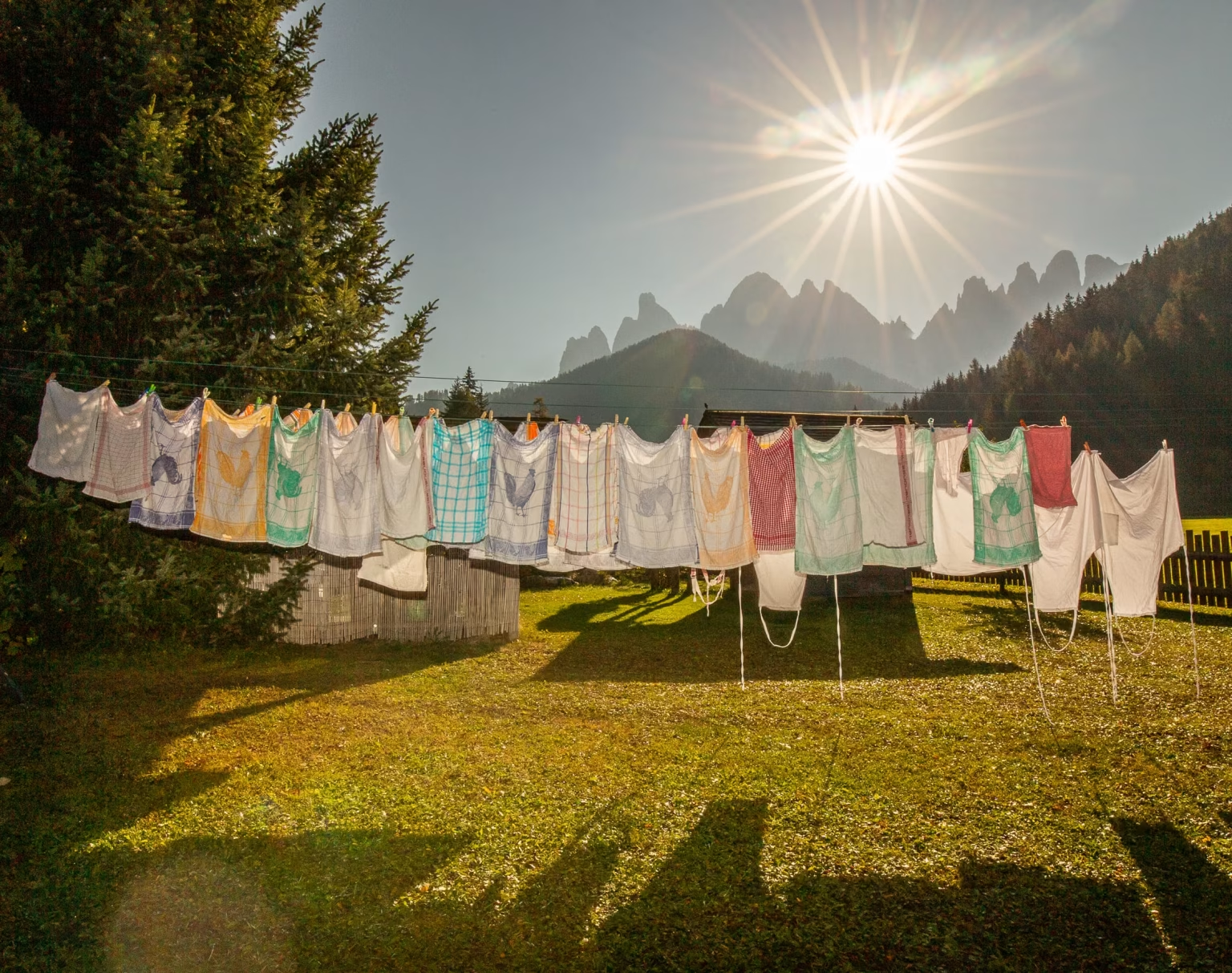
Tiso, at the entrance of the valley, is known for its mineralogical tradition: the famous Tiso geodes, true natural gems, are collected and showcased inside the small but fascinating Mineralogical Museum, perfect for a family visit. The village is peaceful and surrounded by apple orchards and vineyards, ideal for those seeking tranquility and beautiful walks in nature.
San Valentino is a tiny hamlet nestled in lush greenery, where life flows slowly and you can still breathe the authentic mountain atmosphere of days gone by. It’s the perfect place for those who want to completely disconnect from the hustle and enjoy a truly relaxing vacation.
San Giacomo, not far away, is an equally small hamlet surrounded by forests and traditional farmhouses. It’s an excellent starting point for less-traveled hikes and for getting in direct contact with nature and the local rural way of life.
Colle and Valluzza are the most isolated and quiet hamlets in the valley. Colle is known for its panoramic location, while Valluzza offers a complete immersion in tranquility and rural landscapes. They are perfect destinations for those seeking authentic experiences, perhaps staying in a farmhouse or taking part in the daily life of the locals.
In summer, Val di Funes reveals its full beauty: flowering meadows, fresh air, clear skies, and the Odle peaks dominating the landscape. For hiking enthusiasts, the valley offers a dense network of trails suitable for all levels.
Easy trails, like the one connecting Santa Maddalena to San Pietro, are perfect for a relaxing walk through meadows and farmsteads, with stunning views of the Odle peaks. More challenging but truly unforgettable is the Adolf Munkel Trail, which winds at the foot of the Odle through shady forests and panoramic clearings: it’s one of the most scenic routes in the entire Dolomites.
One of the most popular destinations is the Rifugio Odle (Geisleralm), reachable from Zannes via an accessible and well-marked ascent. Once at the top, you can relax on a wooden panoramic deckchair, enjoy a homemade strudel or a plate of canederli while admiring the mountain peaks. Equally pleasant is the walk to Malga Gampen or Dusler Alm, where you can encounter grazing cows and savor Tyrolean cuisine in a charming rural setting.
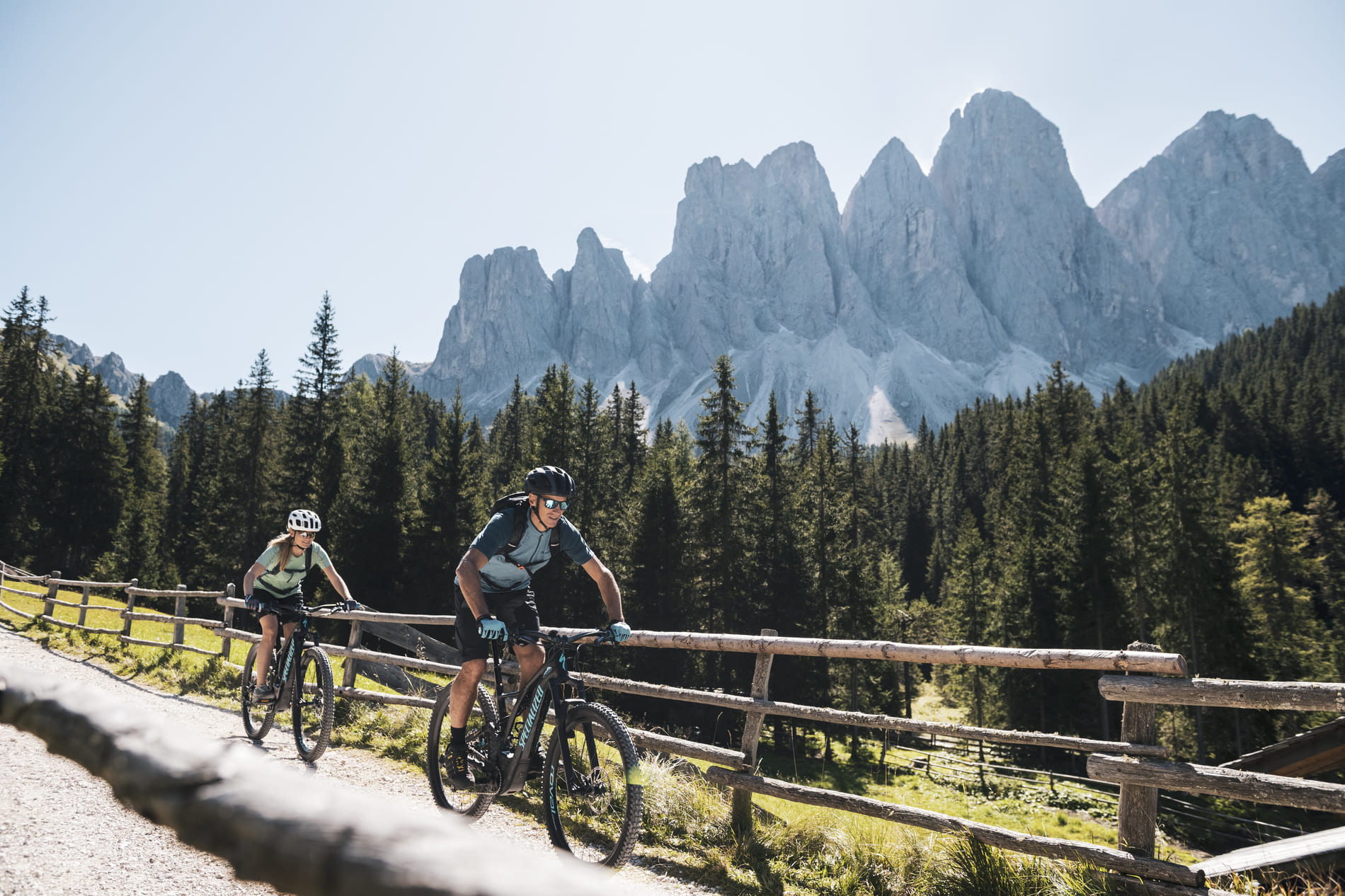

For families, summer in Val di Funes is ideal: besides easy walks, there are themed trails for children, such as the “Nature Trail” starting from Zannes, where little ones can discover the flora, fauna, and curiosities of the Puez-Odle Nature Park. The Funes Adventure Park, with suspended bridges among the trees and zip lines, is perfect for spending a few hours filled with adrenaline and fun.
Bike lovers can rent e-bikes at various spots in the valley, including Santa Maddalena and Zannes, and follow routes along forest roads and gentle trails that connect alpine huts and scenic viewpoints without too much effort. An e-bike tour up to the Passo delle Erbe is an exciting experience, offering ever-changing panoramas and the chance to stop at mountain huts and refuges along the way.
In autumn, Val di Funes offers unique experiences with spectacular foliage, tranquility and tradition. The warm colors can be admired along the trails between San Pietro and Santa Maddalena or on the Adolf Munkel Trail, perfect for walking among golden larches. It’s also the ideal time for mushroom hunting, always in accordance with local regulations; some accommodations offer guided outings with mycologists to learn how to identify mushrooms safely.
Many alpine huts and refuges, such as Malga Gampen and Geisleralm, remain open until late October and are perfect stops after a walk, offering warm Tyrolean dishes to enjoy by the stove. In September, the South Tyrol IGP Speck Festival livens up the valley with food stalls, traditional music, and workshops for all ages.
Photography lovers will find this season offers the most beautiful light of the year: the view of the Chapel of St. John in Ranui at sunset is one of South Tyrol’s most iconic scenes. The trails to Rifugio Odle or the path to Tiso, passing through chestnut trees and fir forests, also provide unforgettable panoramas and a refreshing atmosphere.

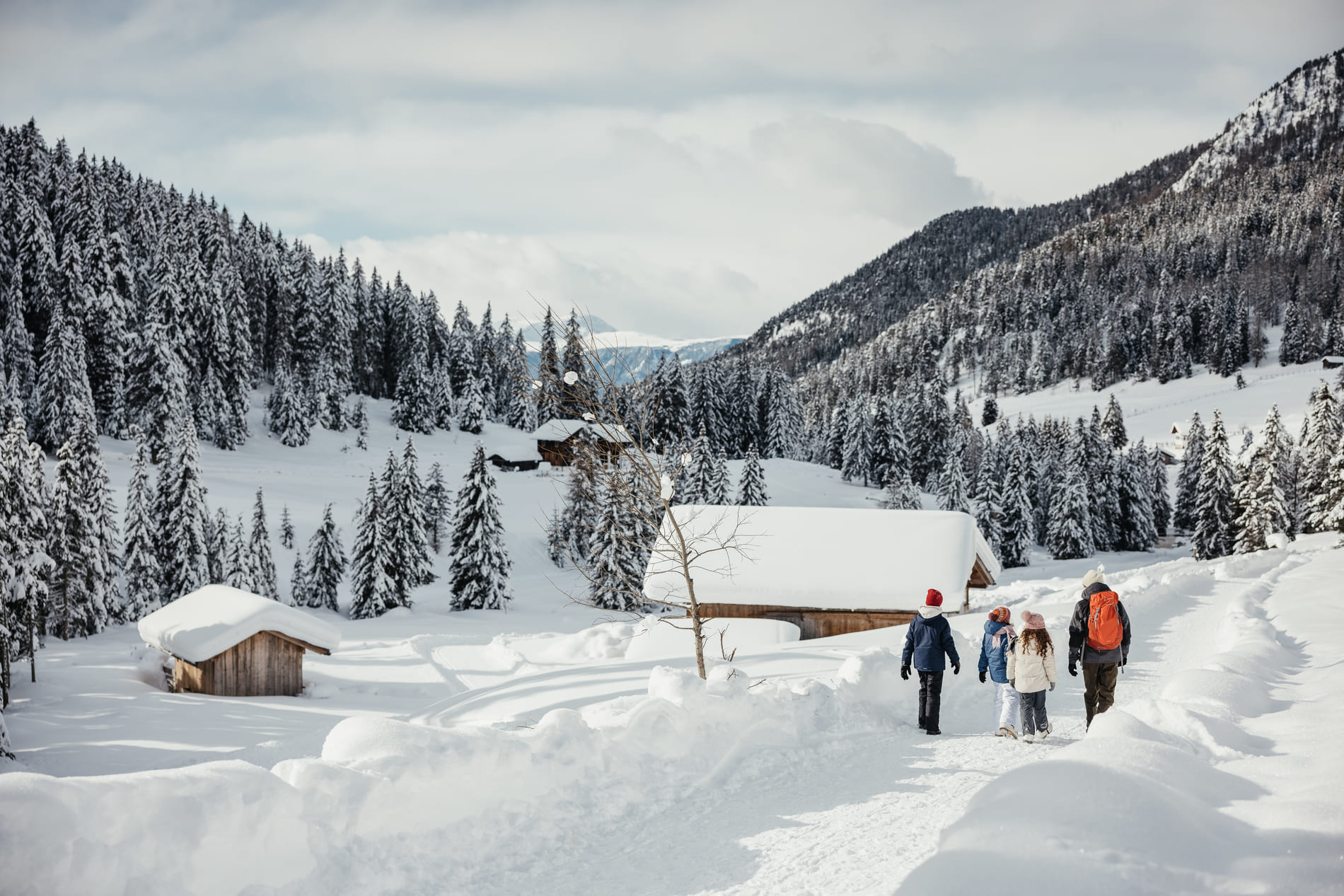
In winter, Val di Funes isn’t a place for those seeking the glamour of ski resorts, but for those who love the authentic mountain experience, even in the coldest season.
Snowshoeing is one of the most popular activities: you can explore the snow-covered trails starting from Zannes, walking through larch forests and open clearings with views of the Odle peaks. A particularly charming route leads to Dusler Alm, which is accessible even in winter, where you can stop for a warm snack of strudel and alpine herbal teas. For those seeking an even more magical experience, there are guided moonlit snowshoe hikes organized by local guides, complete with lanterns and valley stories under the starry sky.
For families or anyone looking for some fun, there are also sledding runs, such as the one starting from Malga Gampen and descending all the way to the valley: perfect for both adults and children. Sleds can be rented directly at the malga or at designated rental spots.
Although the valley is not a traditional skiing destination, there is a small ski lift in Filler, near Santa Maddalena: a few easy slopes, ideal for those who want to learn to ski calmly or for beginners, especially children. For those seeking larger ski areas, the Plose resort above Bressanone or the Val Gardena area between Ortisei and Selva can be reached easily by car in about 30-40 minutes.
During the Advent season, the atmosphere becomes even more enchanting: the Krampusläufe (Krampus parades) bring the village streets to life with traditional devilish masks, while local artisan markets sell handmade decorations, honey, herbal teas and typical regional products. The Christmas lights in small villages like San Pietro or Santa Maddalena make everything feel more intimate and fairy-tale like.
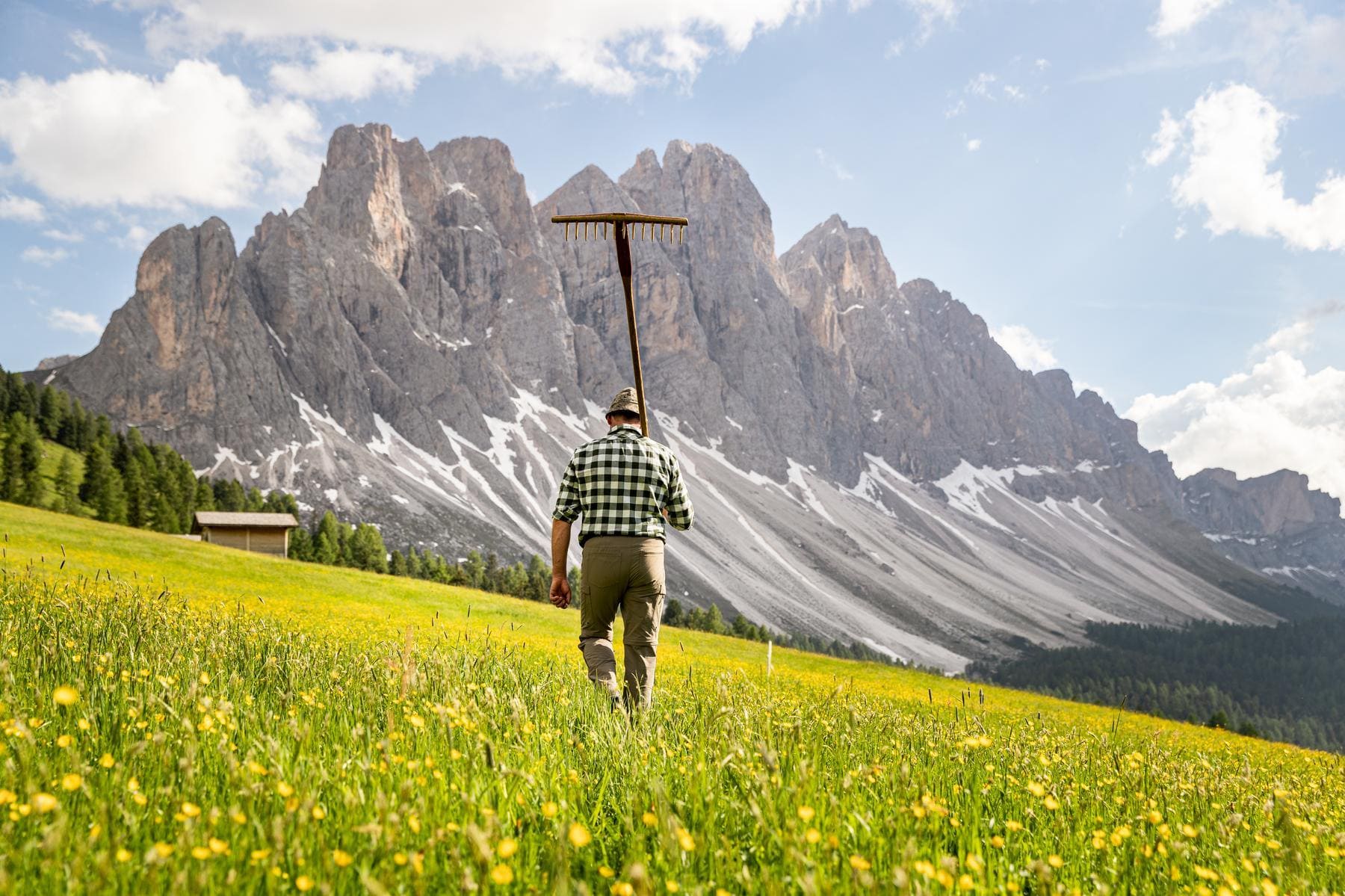
In spring, the Val di Funes slowly awakens under the gentle March and April sun. It’s the perfect time to return to walking the lower trails, such as the relaxing stroll that connects San Pietro to Santa Maddalena, passing through meadows dotted with flowers and historic farmsteads. Another recommended route is the one from Tiso to San Valentino, crossing chestnut groves, blossoming apple orchards, and small villages still connected to rural life. All this with views of the Odle, still dusted with snow.
In this season, you can also visit the Church of San Giovanni in Ranui, surrounded by a green carpet and offering a unique atmosphere at sunset or sunrise. Photographers find spring provides the best light and the clearest panoramas to capture this iconic view.
Spring is also a time for local experiences: you can take botanical walks to discover wild herbs, join traditional cooking workshops, or visit educational farms that reopen their doors to visitors. The most curious can also dedicate themselves to observing migratory birds or exploring the geodes of Tiso, blending science, nature and history.